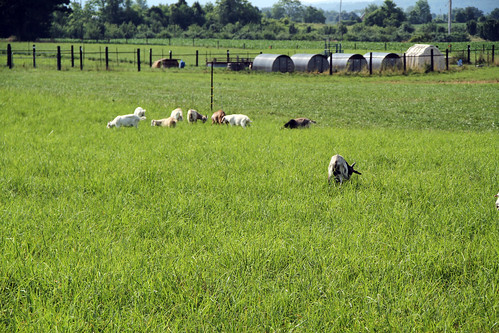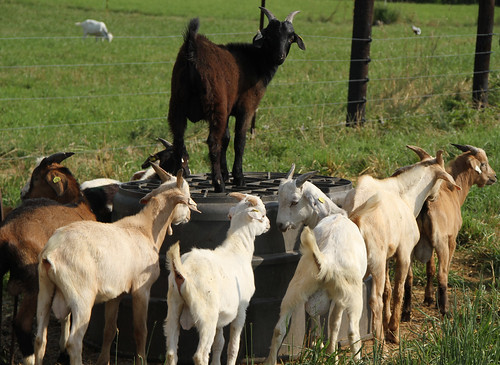Starting weights were determined this week. The goats were weighed on June 14 and June 15 (same time each day - early am) and their starting weights were determined by averaging the two weights. For the 49 goats in the test, starting weights ranged from 29.0 to 64.5 lbs. and averaged 46.4 ±8.3 lbs. (21.1 ±3.8 kg). The median weight was 47 lbs. (21.4 kg).
FAMACHA© scores ranged from 1 to 5 and averaged 2.1 ±0.7, virtually unchanged from June 2. For the sample collected on June 2, fecal egg counts ranged from 0 to 15,150 eggs per gram and averaged 2,437 ±3,337 epg. The median egg count was 1,257 epg. The large standard deviation is indicative of a wide variation in fecal egg counts. In fact, the genetic variability of fecal egg counts makes selection for parasite resistance very promising.
Two thousand eggs per gram (2,000 epg) is considered to be of clinical significance for the barber pole worm, according to one source. Goats that have fecal egg counts over 2,000 (after June 2) will not meet the gold, silver, or bronze standards of the test.
A fecal sample was collected from each goat on June 13. This sample will be compared with the sample collected on June 2 to determine the effectiveness of the triple deworming (moxidectin + albendazole + levamisole).
If eggs counts have been sufficiently reduced, the goats will be dosed with 1,000 Haemonchus contortus stage 3 larvae next week. The purpose of giving larvae is not to challenge the goats, but rather to get some more infective larvae on the pasture. Low egg counts and good FAMACHA© scores are meaningless unless the goats are sufficiently challenged by worms.
Body condition scores averaged 2.5 and were unchanged from June 2. Coat condition scores averaged 2.1 compared to 2.2 on June 2. Only four of the goats had positive dag scores. Last year, 44 percent of the goats showed some evidence of scouring during the adjustment period.
Grazing conditions are ideal. Forage is plentiful and of good quality. Temperatures have been balmy, usually in the 70's and 80's. Rainfall has been ample, without stressing the goats. The goats have adjusted extremely well to their new environment and test mates.
During the adjustment period (June 2-June 14), they gained an average of 6.3 ±3.1 lbs. That works out to an average daily gain (ADG) of almost 0.5 lbs. per day. We hope they continue to gain that well throughout the test.
None of the goats have gotten sick and required special treatment. In previous tests, some of the goats usually experience respiratory symptoms as they adjusted to their new environment. While a couple of goats still have poor FAMACHA© scores, they appear vigorous and have put on weight.
A few goats were issued new ear tags, in order to correct some tagging mistakes.
The goats were weighed by Jeff Semler and David Gordon. Susan Schoenian determined FAMACHA©, body condition, coat condition, and dag scores and collected fecal samples. Pam Thomas and David Gordon recorded data. A student volunteer assisted with fecal sample collection.
The goats will be worked next on June 28. They will receive the worm larvae on June 21 via an oral drenching syringe.
Download June 14 report
View images on Flickr™
FAMACHA© scores ranged from 1 to 5 and averaged 2.1 ±0.7, virtually unchanged from June 2. For the sample collected on June 2, fecal egg counts ranged from 0 to 15,150 eggs per gram and averaged 2,437 ±3,337 epg. The median egg count was 1,257 epg. The large standard deviation is indicative of a wide variation in fecal egg counts. In fact, the genetic variability of fecal egg counts makes selection for parasite resistance very promising.
 |
| Goat "playground" |
Two thousand eggs per gram (2,000 epg) is considered to be of clinical significance for the barber pole worm, according to one source. Goats that have fecal egg counts over 2,000 (after June 2) will not meet the gold, silver, or bronze standards of the test.
A fecal sample was collected from each goat on June 13. This sample will be compared with the sample collected on June 2 to determine the effectiveness of the triple deworming (moxidectin + albendazole + levamisole).
 |
| Kiko buck consigned by Sam Burke (Delaware) |
If eggs counts have been sufficiently reduced, the goats will be dosed with 1,000 Haemonchus contortus stage 3 larvae next week. The purpose of giving larvae is not to challenge the goats, but rather to get some more infective larvae on the pasture. Low egg counts and good FAMACHA© scores are meaningless unless the goats are sufficiently challenged by worms.
Body condition scores averaged 2.5 and were unchanged from June 2. Coat condition scores averaged 2.1 compared to 2.2 on June 2. Only four of the goats had positive dag scores. Last year, 44 percent of the goats showed some evidence of scouring during the adjustment period.
 |
| Grazing a new paddock |
Grazing conditions are ideal. Forage is plentiful and of good quality. Temperatures have been balmy, usually in the 70's and 80's. Rainfall has been ample, without stressing the goats. The goats have adjusted extremely well to their new environment and test mates.
During the adjustment period (June 2-June 14), they gained an average of 6.3 ±3.1 lbs. That works out to an average daily gain (ADG) of almost 0.5 lbs. per day. We hope they continue to gain that well throughout the test.
None of the goats have gotten sick and required special treatment. In previous tests, some of the goats usually experience respiratory symptoms as they adjusted to their new environment. While a couple of goats still have poor FAMACHA© scores, they appear vigorous and have put on weight.
 |
| New pasture coming up (millet + rape) |
A few goats were issued new ear tags, in order to correct some tagging mistakes.
The goats were weighed by Jeff Semler and David Gordon. Susan Schoenian determined FAMACHA©, body condition, coat condition, and dag scores and collected fecal samples. Pam Thomas and David Gordon recorded data. A student volunteer assisted with fecal sample collection.
 |
| Somebody's got to be on top. |
The goats will be worked next on June 28. They will receive the worm larvae on June 21 via an oral drenching syringe.
Download June 14 report
View images on Flickr™











